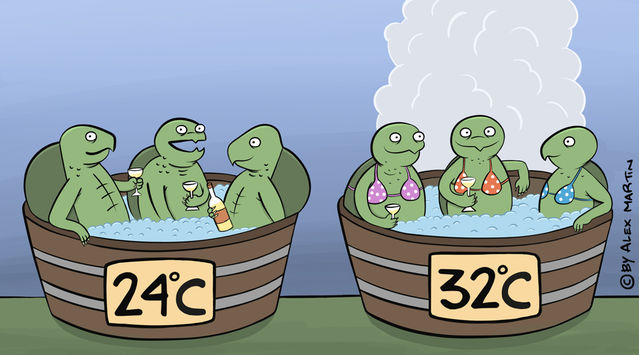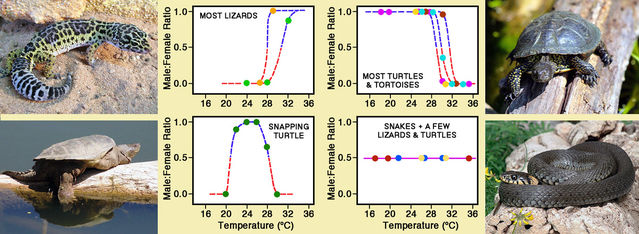Sex
Intersex: Life in the Overlap Zone
Biological differences do not completely separate men from women.
Posted September 24, 2019

My previous blog post aimed to show why it is important to distinguish sex from gender (No Substitute for Sex, posted August 20, 2019). Following a definition from the World Health Organization, I baldly stated that sex is biological whereas gender is cultural. However, numerous comments convinced me that things are not that simple. Defining biological determinants of sex is fairly straightforward, but the meaning of “gender” is far from self-evident. Many environmental factors other than social context can fine-tune sexuality.
Humans, like other mammals, have specific chromosomes that play a key rôle in sexual development, so it might appear that males and females are clearly separated biologically. However, that division is by no means absolute because variations in chromosomes, hormones and a number of primary and secondary sex characteristics can exist. Intersex people are those who are born with a combination of sex traits–some traditionally considered male, some traditionally considered female, and some atypical for either–all in the same body. In addition, certain environmental factors can influence sexual development, further complicating matters.
The sex/gender issue is allied to the age-old “nature versus nurture” discussion concerning the relative contributions of inherited and environmental factors. One response to my last blog post was “nature and nurture are inseparable”. It is now generally accepted that nature and nurture always interact, but we do need to recognize these categories for clear analysis.
In an opinion piece for New Scientist four decades ago, I wrote: “Man is not an onion; one cannot simply peel away surface layers of culture to expose a biological homunculus lurking inside. Any attempt to analyse a biological contribution to human behaviour in the absence of penetrating analysis of human cultural attributes is doomed to failure. For instance, no behavioural differences between the sexes in humans can be uniquely biological or uniquely cultural. It is as meaningless to talk of inherited dominance of males over females as it is to propose a tabula rasa (blank slate) in sex differences.”
I eventually realized that a more appropriate analogy for the nature/nurture distinction is not an onion but a cake. Sponge cake needs only six ingredients: butter, sugar, eggs, flour, yeast, cream. Once mixed, and especially after baking in the oven, those ingredients are physically inseparable. A finished cake has novel features (emergent properties) that cannot be “explained” by any single ingredient. However, starting from a finished cake, at least some original ingredients may be identified using scientific methods. Distinguishing cream from butter is admittedly challenging, but sophisticated analysis could reveal the grain yielding the flour, a likely source of the eggs and the kind of yeast used. Once blended and baked, the ingredients are indeed physically inseparable, but they are nevertheless identifiable!

The biological basis for sex
In mammals generally, biological sex depends on two types of sex chromosomes, X and Y. Typically, cells in female bodies (except eggs) have two X chromosomes, while cells of all males (except sperms) possess one X and one Y. This provides a very simple basis for producing roughly equal numbers of female and male offspring. During sex cell production the number of chromosomes is halved so that only one sex chromosome is typically present: X in all eggs and X or Y in sperms. Sperm/egg fusion at fertilization restores the number of sex chromosomes to two. Human body cells have 23 pairs of chromosomes, reduced to 23 single chromosomes in sex cells. Contrasting with the two sex chromosomes, the remaining 22 pairs are “household chromosomes” (autosomes) that maintain bodily functions in males and females alike.

Apart from mammals, many other animals have a comparable system with a pair of sex chromosomes. However, males do not always have two different sex chromosomes. In birds and snakes, for instance, a male has two Z chromosomes, while a female has one Z and one W chromosome. Sex chromosomes had distinct evolutionary origins in mammals, birds and snakes, as Kazumi Matsubara and colleagues convincingly demonstrated in a 2006 paper. The reptilian common ancestor of mammals and birds, some 315 million years ago, presumably had no sex chromosomes. As is still true of many animal groups today, sex was probably determined initially by genes carried on household chromosomes, rather than by distinct sex chromosomes.

Among modern reptiles, sex determination actually varies widely, ranging from direct influences of environmental temperature (reviewed by James Bull in 1980) to the W/Z system in snakes. It is widely thought that sex was environmentally determined in ancestral animals with backbones (vertebrates). Sex determination became tightly controlled by specific chromosomes in certain descendant lineages, such as mammals (including ourselves).
Variations in sex chromosomes
During sex cell production, deviations from standard cell division can yield atypical chromosome compositions that are perpetuated in the body cells during development following fertilization. For human sex chromosomes, the commonest example is Klinefelter’s, in which a person possesses an additional X chromosome per body cell (XXY), hence having 47 chromosomes instead of the usual 46. Sometimes, two or even more extra X chromosomes are present. Klinefelter’s occurs in one out of 800 babies born.
Another example is Turner’s, in which one of the two X chromosomes is partially or completely missing. If one X chromosome is entirely absent (XO), body cells have only 45 chromosomes instead of 46. Turner’s occurs in one out of 8000 babies born.
Hormonal variation
Hormones commonly mediate effects of sex chromosomes. However, hormones can also influence sexual development independently. Various alternative forms of genes on household chromosomes can affect biological sex characteristics. Indeed, gene variations responsible for congenital adrenal hyperplasia (CAH) modify sexual development far more often than an atypical set of sex chromosomes. Individuals with sex chromosomes differing from the customary XX or XY are relatively rare, with a frequency of about two cases per 1000 births. By contrast, about fifteen cases of CAH occur per 1000 births.
CAH occurs in individuals possessing a standard “female” set of two X chromosomes and includes several genetic conditions that affect production of steroid hormones by the adrenals (walnut-sized glands above the kidneys). Most conditions involve over- or under-production of sex steroids, potentially altering development of sex characteristics at some stage. By far the commonest type of CAH, accounting for 95% of cases, is 21-hydroxylase deficiency. With this kind of CAH, the adrenals produce excess male sex hormones (androgens), resulting in masculinization. Side-effects include clitoris enlargement and incomplete development of the vagina.

Medical data reviewed by Melanie Blackless and colleagues in a 2000 paper reveal that the overall frequency of atypical chromosomal and hormonal traits in intersex people is close to one in fifty. Accordingly, in the current US population of almost 330 million over 6 million individuals with some form of intersex, or intersex variation, are to be expected. Approximately the same proportion of people have red hair.
Some implications
Given the remarkably high incidence of intersex cases in the human population and the predominance of hormonal influences unconnected with sex chromosomes, rigid male/female separation is unjustifiable even biologically. And the advent of environmental pollution that may directly affect sexual development further obscures any distinction. As Melanie Blackless and colleagues concluded: “ ……… the requirement for medical intervention in cases of intersexuality needs to be carefully reexamined. It seems likely that changing cultural norms concerning sex roles and gender-related behaviors may encourage a willingness to engage in such a reexamination." Clearly, intersex people deserve sympathetic understanding. In particular, medical interventions should not be performed on intersex infants and children. Rather than assuming an absolute male/female distinction and trying to “fix” them, they should be allowed to preserve the natural variation in their biological sex features.
[P.S. I am once again very grateful to Claudia Astorino—an active advocate for intersex people—for providing extremely useful editorial comments on a draft version of this blog post.]
Important Note
Anyone who wishes to find out more about intersex from a reliable and informative source can do so through the admirable youth intersex organization InterAct, using the following link:
https://interactadvocates.org/
References
Astorino, C.M. (2019) Beyond dimorphism: Sexual polymorphism and research bias in biological anthropology. American Anthropologist 121:489-490.
Baskin, L., Shen, J., Sinclair, A., Cao, M., Liu, X., Liu, G., Isaacson, D., Overland, M., Li, Y. & Cunha, G.R. (2018) Development of the human penis and clitoris. Differentiation 103:74-85.
Blackless, M., Charuvastra, C., Derryck, A., Fausto-Sterling, A., Lauzanne, K. & Lee, E. (2000) How sexually dimorphic are we? Review and synthesis. American Journal of Human Biology 12:151-166.
Bull, J.J. (1980) Sex determination in reptiles. Quarterly Review of Biology 55:3-21.
Lanfranco, F., Kamischke, A., Zitzmann, M. & Nieschlag, E. (2004) Klinefelter's syndrome. Lancet 364:273-283.
Martin, R.D. (1977) Man is not an onion. New Scientist 75:283-285.
Matsubara, K., Tarui, H., Toriba, M., Yamada, K., Nishida-Umehara, C., Agata, K. & Matsuda, Y. (2006) Evidence for different origin of sex chromosomes in snakes, birds, and mammals and step-wise differentiation of snake sex chromosomes. Proceedings of the National Academy of Sciences U.S.A. 103:18190-18195.
McElreavey, K. & Fellous, M. (1997) Sex-determining genes. Trends in Endocrinology & Metabolism 8:342-346.
Nelson, C. & Gearhart, J. (2004) Current views on evaluation, management and gender assignment of the intersex infant. Nature Clinical Practice Urology 1:38-43.
Vallender, E. & Lahn, B.T. (2006) Multiple independent origins of sex chromosomes in amniotes. Proceedings of the National Academy of Sciences U.S.A. 103:18031-18032.




